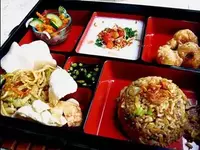The asian

Asian cuisine is a generalizing concept that includes Japanese, Chinese, Vietnamese, Korean, Thai, Malaysian and Filipino cuisine. Of course, each of the above national cuisines has its own specifics, but there are some common features that allow you to combine all these so diverse culinary traditions into a holistic concept, which is called Asian cuisine.
First of all, it should be noted that all Asian dishes are fragrant, spicy, tasty, but at the same time surprisingly light. Europeans and Americans, relatively recently introduced to ancient Asian traditions, are very fond of Asian cuisine recipes, which really cannot leave anyone indifferent.
The main and key feature of Asian cuisine is the huge number of rice dishes. Rice in Asian recipes takes as much pride of place as potatoes for Europeans. Asians have little idea of a meal that could do without rice. But here, too, each national cuisine has its own characteristics. For example, in Japan they prefer round rice, and in Thailand - sticky long jasmine rice, in India a variety of long-grain rice is widespread - basmati.
It is difficult to imagine recipes for Asian cuisine without traditional noodles. It is usually made from eggs with the addition of wheat flour. Egg noodles are served along with soups and salads, and seasoned, as a rule, with soy sauce. In addition to soy sauce, fish sauce is common in Asian cuisine, in its properties it largely resembles soy sauce and very often replaces salt in dishes.
Among other additives and related products, one cannot fail to mention ginger, wasabi, coconut milk, chilli seasoning, curry paste, tofu cheese, as well as seaweed.
Asian cuisine is primarily sauces and spices. We have already mentioned sauces, now it is worth talking about seasonings. Here, too, it does not do without local specifics. For example, in Korea, fried sesame is used as the main seasoning. It is added to almost every dish. And in China, they prefer fennel, Sichuan pepper, anise, cinnamon, badiyang, as well as the local invention - wuxiangmian - seasoning, which is a mixture of cinnamon, fennel, cloves, Sichuan pepper and badyan, taken in equal shares.
Among drinks, tea occupies a leading position in Asian cuisine. China is considered the birthplace of tea, however, the traditions of tea drinking are very ancient and have survived in almost all Asian countries, and have remained practically unchanged since time immemorial. Of alcoholic beverages, Asians prefer sake - rice vodka, in addition, they also love wine and beer.
If we talk about traditional Asian dishes, then here, without a doubt, sushi, sashimi and many other diverse culinary masterpieces made of fish and seafood are worthy of mention. Another traditional component of Asian cuisine is rice and meat dishes (mainly pork and chicken meat), and variations on this topic in Asian recipes are truly countless.
Asian cuisine is a very ancient cuisine, rich in long traditions, which are diligently stored and passed down from generation to generation.
 Español
Español Français
Français Português
Português Русский
Русский 简体中文
简体中文 繁體中文
繁體中文 日本語
日本語 한국어
한국어 العربية
العربية Türkçe
Türkçe Қазақ
Қазақ Deutsch
Deutsch Italiano
Italiano Українська
Українська
